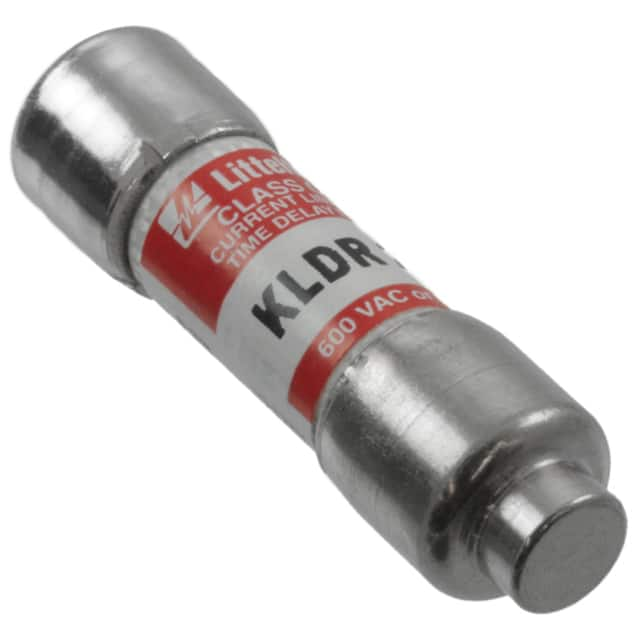KLDR2.25T Fuse
Introduction
The KLDR2.25T fuse is a vital component in electrical systems, providing protection against overcurrent conditions. This entry will provide an overview of the KLDR2.25T fuse, including its product category, basic information, specifications, detailed pin configuration, functional features, advantages and disadvantages, working principles, application field plans, and alternative models.
Product Category
The KLDR2.25T fuse belongs to the category of electrical fuses, specifically classified as a time-delay, ceramic tube fuse.
Basic Information Overview
- Use: The KLDR2.25T fuse is utilized for protecting electrical circuits from overcurrent conditions.
- Characteristics: It exhibits time-delay characteristics, allowing temporary overloads without sacrificing protection.
- Package: The fuse is typically housed in a ceramic tube with metal end caps for secure installation.
- Essence: Its essence lies in providing reliable overcurrent protection in various electrical applications.
- Packaging/Quantity: The fuse is commonly available in bulk packaging, with quantities varying based on supplier and consumer needs.
Specifications
- Voltage Rating: 600V AC/DC
- Current Rating: 2.25A
- Interrupting Rating: 200A @ 600V AC/DC
- Operating Temperature Range: -55°C to 125°C
- Agency Approvals: UL Recognized, CSA Certified
Detailed Pin Configuration
The KLDR2.25T fuse features a cylindrical ceramic body with metal end caps. The end caps serve as the connection points for insertion into the circuit.
Functional Features
- Time-Delay: Provides delayed response to overcurrent conditions, accommodating temporary current surges.
- High Interrupting Rating: Capable of safely interrupting high fault currents, ensuring system protection.
- Compact Design: Occupies minimal space within electrical enclosures or panels.
Advantages and Disadvantages
Advantages
- Reliable Overcurrent Protection
- Time-Delay Feature
- Wide Operating Temperature Range
Disadvantages
- Limited Current Rating
- Replacement Required After Activation
Working Principles
When the current flowing through the fuse exceeds its rated capacity, the internal element heats up, causing it to melt and open the circuit. The time-delay feature allows the fuse to withstand temporary overloads without tripping.
Detailed Application Field Plans
The KLDR2.25T fuse finds extensive use in various applications, including: - Industrial Control Systems - Power Supplies - Motor Drives - HVAC Equipment - Lighting Systems
Detailed and Complete Alternative Models
- KLDR Series: Includes various current ratings to accommodate different circuit protection requirements.
- KTK-R Series: Offers fast-acting alternatives for applications where time-delay is not critical.
In conclusion, the KLDR2.25T fuse serves as a crucial protective device in electrical systems, offering reliable overcurrent protection with its time-delay characteristic and high interrupting rating. Its compact design and wide operating temperature range make it suitable for diverse applications across industries.
Word Count: 410
10个与KLDR2.25T在技术解决方案中的应用相关的常见问题及解答
What is KLDR2.25T?
- KLDR2.25T is a fast-acting fuse designed for use in electronic and electrical systems to protect against overcurrent conditions.
What are the typical applications of KLDR2.25T?
- KLDR2.25T is commonly used in power supplies, control circuits, instrumentation, and other electronic equipment where overcurrent protection is required.
What is the voltage and current rating of KLDR2.25T?
- KLDR2.25T has a voltage rating of 600V AC/DC and a current rating of 2.25A.
How does KLDR2.25T provide overcurrent protection?
- KLDR2.25T operates by quickly opening the circuit when an overcurrent condition occurs, thereby preventing damage to the connected components.
Is KLDR2.25T suitable for high-temperature environments?
- Yes, KLDR2.25T is designed to operate reliably in high-temperature environments, making it suitable for various industrial applications.
Can KLDR2.25T be used in automotive electronics?
- Yes, KLDR2.25T can be used in automotive electronics to protect sensitive components from overcurrent events.
What are the key features of KLDR2.25T?
- The key features of KLDR2.25T include its fast-acting response, high interrupting capacity, and compact design.
Does KLDR2.25T have any agency certifications?
- Yes, KLDR2.25T is typically UL recognized and meets the requirements of various international standards for overcurrent protection devices.
Are there any recommended mounting and soldering techniques for KLDR2.25T?
- It is recommended to follow the manufacturer's guidelines for proper mounting and soldering of KLDR2.25T to ensure reliable performance.
Where can I purchase KLDR2.25T fuses?
- KLDR2.25T fuses can be purchased from authorized distributors or directly from the manufacturer's website.


